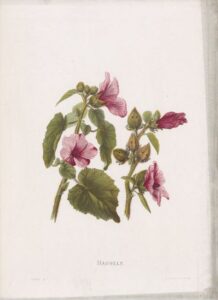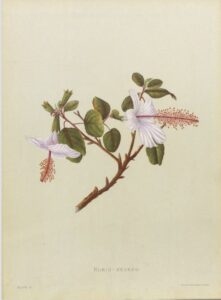Indigenous Flowers of the Hawaiian Islands

In celebration of spring and in honor of Asian/Pacific American Heritage Month, today’s blog post features illustrations of indigenous Hawaiian flowers created by nineteenth-century amateur botanist Isabella McHutcheson Sinclair.

Courtesy of the State Library of Ohio’s Rare Books Collection. Via Ohio Memory.
Isabella McHutcheson was born in Scotland in 1840 and moved with her family to New Zealand as a young child. In 1866, Isabella married her cousin Francis Sinclair and joined him in Hawaii, where his family ran agricultural businesses. The newlyweds settled on the island of Kauai, where Isabella spent her time exploring the island, collecting plant specimens, and learning about the plants’ names and medicinal properties from the indigenous islanders. In addition to taking detailed notes on the plants’ habitats and flowering seasons, she used her specimens to create detailed watercolor paintings of each plant.

Courtesy of the State Library of Ohio’s Rare Books Collection. Via Ohio Memory.
Isabella then wrote to the director of London’s Kew Gardens, Sir Joseph Dalton Hooker, to ask for advice on the scientific names of her specimens. She included her watercolors in the package, and Hooker was so impressed that he encouraged Isabella to publish her observations and her paintings. In 1884, Isabella and her husband traveled to London to publish Indigenous Flowers of the Hawaiian Islands, the first book to include color images of Hawaiian flowers, the following year.
Even as Isabella’s work introduced the exotic flowers of Hawaii to the world, she recognized the fragility of the island ecosystem and the dangers posed by the influx of outside people and plants. In the introduction to her book, she wrote:
The Hawaiian flora seems … to grow in an easy careless way, which, though pleasingly artistic, and well adapted to what may be termed the natural state of the islands, will not long survive the invasion of foreign plants, and changed conditions. Forest fires, animals, and agriculture, have so changed the islands, within the last fifty or sixty years, that one can now travel for miles, in some districts, without finding a single indigenous plant; the ground being wholly taken possession of by weeds, shrubs, and grasses, imported from various countries.”

Courtesy of the State Library of Ohio’s Rare Books Collection. Via Ohio Memory.
According to a September 2021 press release from the Center for Biological Diversity, nearly one-third of threatened and endangered species in the U.S. are Hawaiian. Indigenous Flowers of the Hawaiian Islands provides an important record of nineteenth-century Hawaiian flora and, hopefully, can inspire modern-day artists and citizen scientists, just as the islands inspired Isabella McHutcheson Sinclair.
Thank you to Stephanie Michaels, Research and Catalog Services Librarian at the State Library of Ohio, for this week’s post!



Leave a Reply
You must be logged in to post a comment.